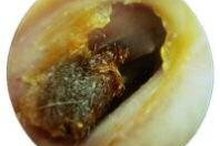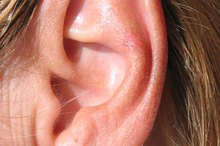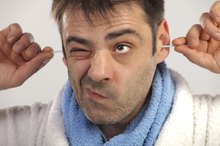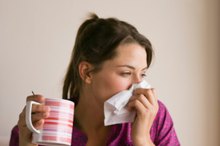Ear Pain After Wax Removal
Earwax is a often considered a nuisance, but it plays an important role in ear health. Also called cerumen, this substance protects the lining of the ear and helps remove debris from the ear canal. But sometimes this wax builds up and blocks the ear canal -- and needs to be removed. While removal has minimal side effects, sometimes minor ear pain can follow. If ear pain is severe, see your doctor.
If you are experiencing serious medical symptoms, seek emergency treatment immediately.
The Problem
Earwax is a natural cleanser for the ears. It not only coats and protects the lining of the ear canal, this substance also traps dead skin, hair and any dirt that enters the ear. Jaw movements from eating and talking help to move this wax outwards towards the ear opening, where it flakes off or gets washed away with bathing. But sometimes this wax builds up in the ear canal and leads to blockage or impaction -- which can cause ear pain. Other signs of wax blockage include decreased hearing, dizziness, itching in the ear canal, a plugged ear sensation, ringing in the ear or an odor or discharge coming from the ear canal. Untreated impaction can also make infections more likely.
- Earwax is a natural cleanser for the ears.
- It not only coats and protects the lining of the ear canal, this substance also traps dead skin, hair and any dirt that enters the ear.
Home Removal
Causes of Calcified Ear Wax
Learn More
There are safe ways to remove earwax at home, but if you don't do it right, you can cause pain and worsen the impaction. Home treatment may simply involve watchful waiting, as the ears may be able to remove the wax without treatment 1. Alternatively, you can use a bulb syringe to gently flush the ears with warm, distilled water, which softens the wax and assists the ears in their natural wax removal process. Over-the-counter (OTC) wax softening drops, mineral oil or drops of hydrogen peroxide can also be tried to break up the earwax and help it migrate out the ear canal. It's important to regularly wipe the outer ear to remove any wax that migrates out of the ear.
Home Treatment Tips
If you have ear pain or suspect you have an ear infection, do not use ear drops or flush your ears with water until you have a doctor assess your ear and approve this home treatment. Use OTC ear drops according to package directions, since prolonged or too-frequent use can lead to irritation and ear discomfort 1. Also, do not use cotton swabs, bobby pins or other tools to clean the ears, as these items can damage the ear or push the wax deeper into the ear canal, causing impaction and discomfort. Ear candles, which are touted to help suction the wax out of the ears, should not be used. Ear candling is not deemed effective and can cause burns, blocked wax or ear damage. Finally, do not irrigate the ears with forceful water as this can damage the eardrum and lead to more pain.
- If you have ear pain or suspect you have an ear infection, do not use ear drops or flush your ears with water until you have a doctor assess your ear and approve this home treatment.
- Use OTC ear drops according to package directions, since prolonged or too-frequent use can lead to irritation, which are touted to help suction the wax out of the ears, should not be used.
Clinic Treatment
Baking Soda & Water for Ear Wax
Learn More
If you have wax buildup which is causing symptoms, or if you do not want to try home removal, an option is to have the wax removed by a healthcare professional. A doctor or nurse has better tools -- and a better view -- so clinic treatment tends to be very successful. A clinician will carefully use a slender, curved instrument to mechanically remove the wax, and may also use a special suction device and irrigation tool for wax removal. After professional earwax removal, you should feel relief and reduced pressure in your ears -- and you should not have pain or discomfort. But if you experience pain after wax removal, let your doctor know.
- If you have wax buildup which is causing symptoms, or if you do not want to try home removal, an option is to have the wax removed by a healthcare professional.
Warnings
Pain after earwax removal could occur if the ear canal was scraped or damaged from the tool used to remove the wax, or if the eardrum was damaged during wax removal. This pain may also be linked to incomplete wax removal, an underlying infection or a ruptured eardrum. Call your doctor if you have severe ear pain, ear discharge that is not wax, loss of hearing, ringing in the ear, or if you have unsuccessfully tried removing wax at home.
Reviewed by Kay Peck, MPH RD
- Pain after earwax removal could occur if the ear canal was scraped or damaged from the tool used to remove the wax, or if the eardrum was damaged during wax removal.
- Call your doctor if you have severe ear pain, ear discharge that is not wax, loss of hearing, ringing in the ear, or if you have unsuccessfully tried removing wax at home.
Related Articles
References
- Merck Manual: Ear Blockages
- American Family Physician: Ear Wax: What You Should Know
- AAO-HNSF Clinical Practice Guideline: Earwax Removal (8/29/2008). American Academy of Otolaryngology- Head and Neck Surgery.
- Klein, Sarah. "This Will Make You Never, Ever Want To Clean Your Ears Again" (7/21/2014). The Huffington Post.
Writer Bio
Regan Hennessy has been writing professionally for 11 years. A copywriter and certified teacher, Hennessy specializes in the areas of parenting, health, education, agriculture and personal finance. She has produced content for various websites and graduated from Lycoming College with a Bachelor of Arts in English.








